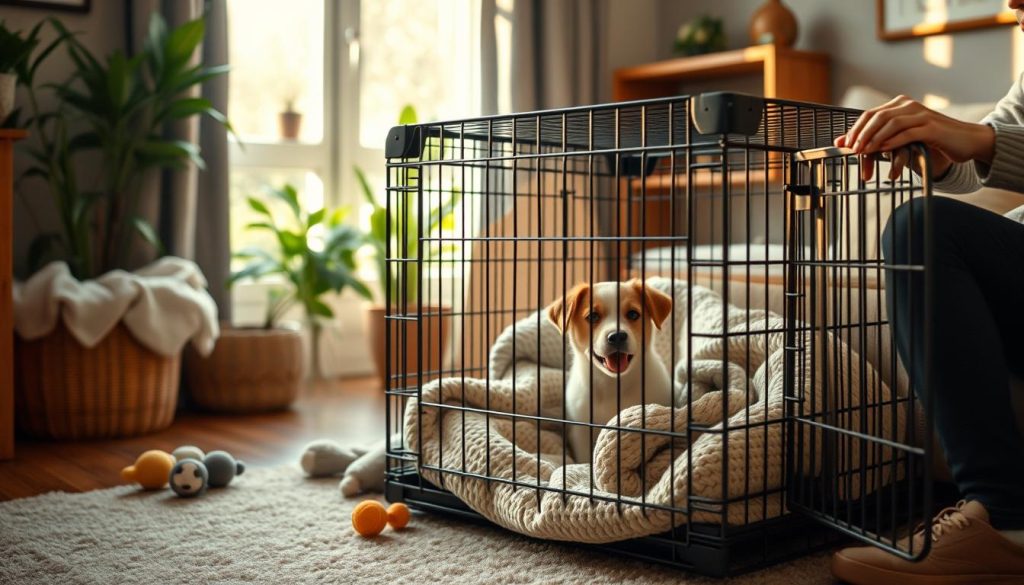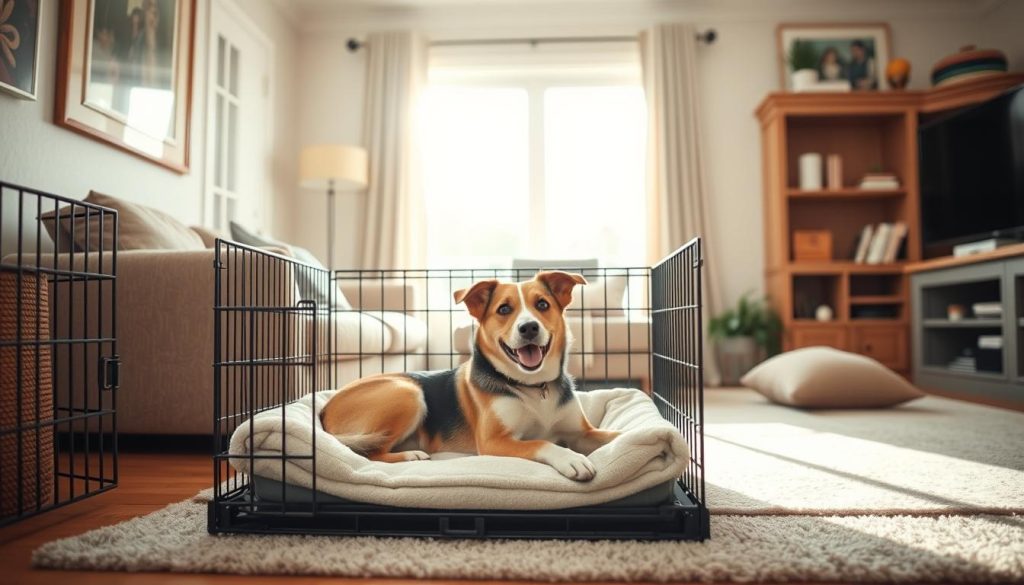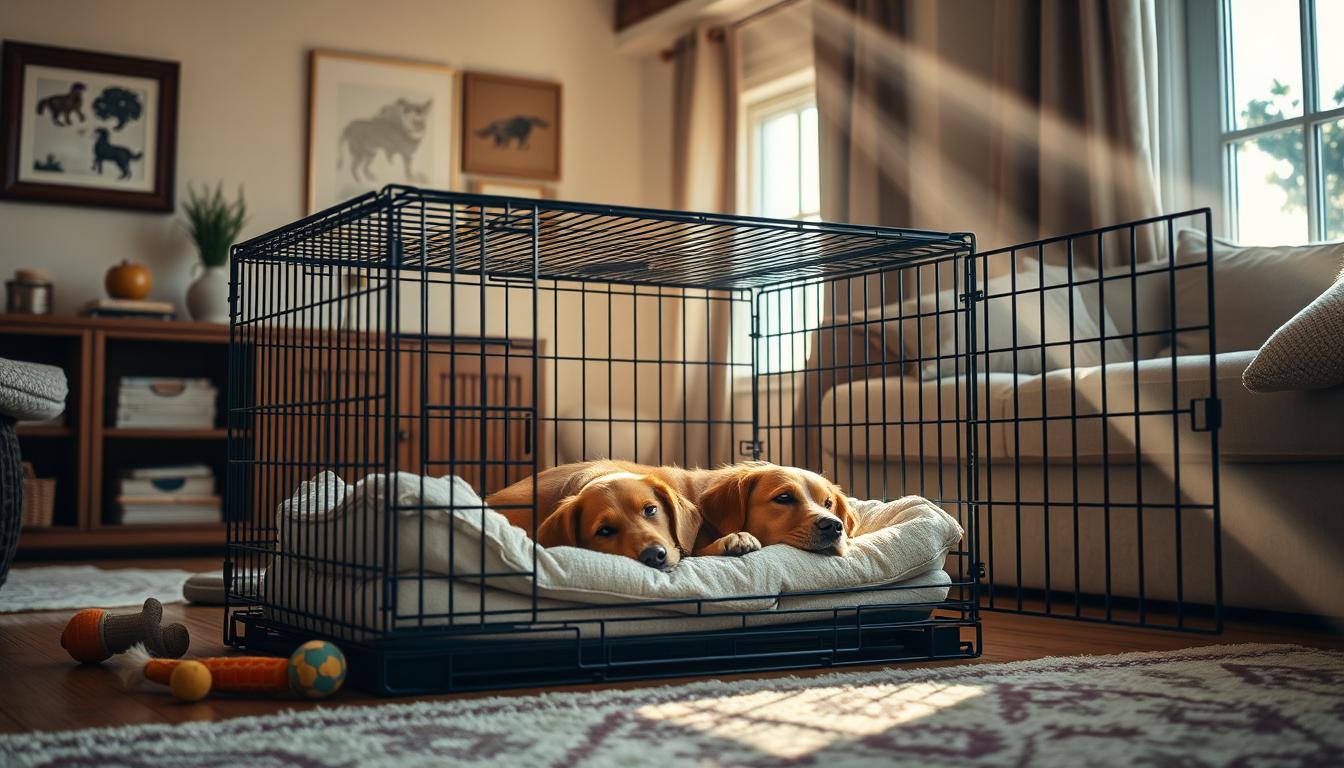As a devoted pet owner, I know how crucial it is to give your furry friend a safe and comfy spot. In this guide, I’ll share top dog crate training tips. These will help you create a positive space for your pup. Whether you’re training a new puppy or helping an older dog feel at home in their crate, these strategies will help you both succeed.
Crate training is a key part of your dog’s growth, and done right, it can change the game for you and your pet. It creates a secure and familiar area. This helps your dog feel safe, stops destructive behavior, and makes housetraining easy. In the next parts, I’ll explain why crate training for dogs is important. I’ll also give you a step-by-step guide to make it easy to start.
Why Crate Training is Important for Your Pup
Crate training is great for you and your dog. It makes a cozy “safe space” for your pup. This helps them feel safe and calm. It also stops them from chewing things or having accidents when you’re not watching.
Establishing a Safe Space
Think of the crate as a cozy den, not a punishment. Start by introducing it slowly and with treats and play. This way, your dog will see the crate as a place of comfort and safety. It’s especially good for puppies, helping them feel safe during their socialization period.
Preventing Destructive Behavior
Crate training helps stop destructive behavior when you’re not there. It keeps your dog in a safe, comfy spot. This stops them from chewing, having accidents, or getting into trouble when you’re not around.
It’s also key for crate training puppies during house-training. It helps them learn where to go to the bathroom.
The benefits of crate training dogs are clear. It gives them a sense of security, reduces anxiety, and stops bad behavior. By making the crate a positive place, you keep your dog safe and your home in order.
Dog Crate Training: A Step-by-Step Guide

Training your dog to use a crate takes time and patience. But with a clear plan, you and your dog can succeed. I’ll show you how to pick the right crate size and help your dog get used to it. With the right crate training tips and techniques, it can be easy and stress-free for both of you.
- Select the Appropriate Crate Size: Measure your dog and pick a crate that lets them stand, turn, and lie down easily. The right crate size is key for your dog’s comfort and success in crate training.
- Introduce the Crate Gradually: Place the crate in a busy area of your home and leave the door open. Put treats or their favorite toy inside to encourage them to explore. This makes the crate a positive place for them.
- Teach the “Crate” Command: When your dog is okay with the crate, start teaching them the “crate” command. Use a treat to guide them in, and praise and reward them when they go in willingly.
- Increase Crate Time Slowly: Start with short crate times and slowly increase it as your dog gets more comfortable. Never push your dog into the crate or leave them for too long.
- Provide Positive Reinforcement: Always give your dog treats, praise, or a favorite toy when they go into the crate. This makes the crate a positive place for them.
Remember, crate training a dog needs patience and consistency. By following these step-by-step crate training tips, your dog will feel safe and secure in their new “den.
Choosing the Right Crate Size

Size is key when picking a dog crate. The right size ensures your dog’s comfort and helps with crate training. Let’s explore the measurements and guidelines to find the perfect crate for your dog.
Measurements and Guidelines
To find the ideal crate size, consider a few important factors:
- Dog’s Height: Measure from the floor to the top of your dog’s head. The crate should be tall enough for your dog to stand and turn around.
- Dog’s Length: Measure from the nose to the tail base. The crate should be long enough for your dog to lie down and stretch.
- Dog’s Weight: Check the crate manufacturer’s size recommendations based on your dog’s weight. This ensures the crate is sturdy and secure.
The crate should be just big enough for your dog to stand, turn, and lie down comfortably. Avoid too big crates as they can hinder training and lead to destructive behavior.
| Dog’s Weight | Crate Size |
|---|---|
| Up to 10 lbs | 18-inch crate |
| 11-25 lbs | 24-inch crate |
| 26-40 lbs | 30-inch crate |
| 41-70 lbs | 36-inch crate |
| 71-90 lbs | 42-inch crate |
| 91-110 lbs | 48-inch crate |
By following these guidelines, you can find the right crate size for your dog. This ensures their comfort and a successful crate training experience.
Creating a Positive Association
The key to successful crate training is to make your dog see their crate as safe and comfy. Use positive reinforcement to help them enjoy being in it. This way, they’ll look forward to spending time there.
Begin by putting your dog’s favorite treats and toys inside the crate. Encourage them to explore and get used to the space. As they get more comfortable, start to increase the time they spend in it. Always give them praise and treats when they go in willingly. This helps them understand the crate as a safe and happy place, not a prison.
Remember, crate training takes time. Be patient and adjust your approach to fit your dog’s needs and personality. By making crate time positive, you’ll help your dog feel safe and confident. They’ll see their crate as a cozy place to relax, not a punishment.

